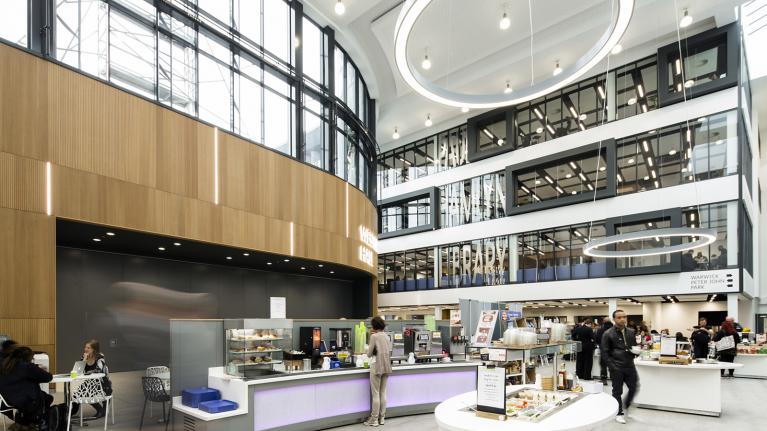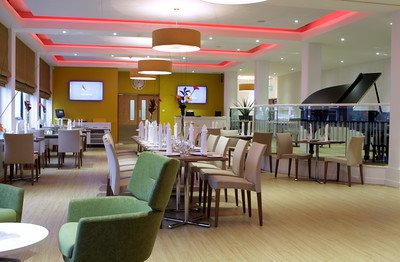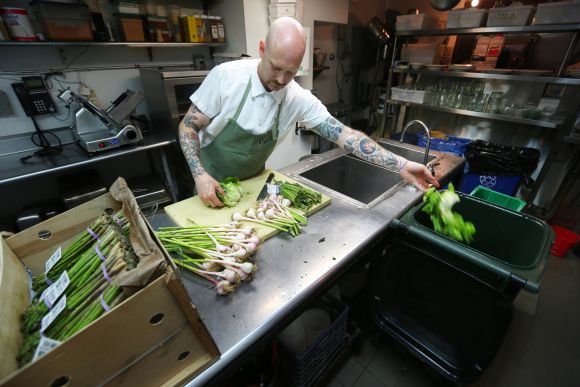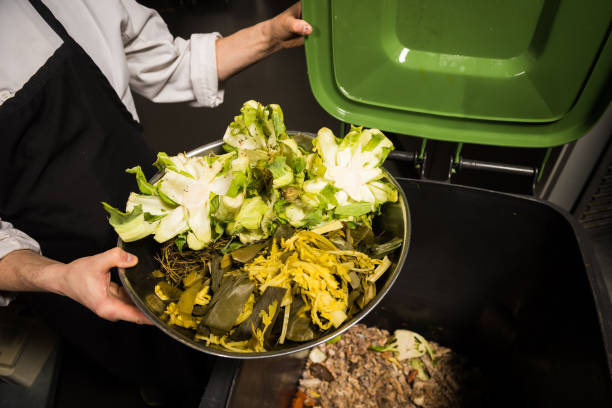This research reviews the role that sustainability plays in the hospitality industry. The case study used is Pillars Restaurants, a student learning kitchen in London. The research carried out is secondary in nature to provide sufficient data to come up with recommendations the restaurant can adopt to achieve sustainability. The first section is the introduction part that outlines the type of research carried out, the background information of the case study, and the challenges faced when carrying out the study. The second section includes various aspects of the restaurant is reviewed including procurement, food safety practices, healthy menus, efficient energy usage, and waste management. These aspects form the different issues tackled during the research. The last part is the conclusion which entails in brief what the research was all about.
Introduction
Essentially, sustainability refers to anything that can be sustained over an extended period of time. This implies that an unsustainable civilization will not be able to exist for long and will eventually come to an end (Taylor, 2010). As a result, some environmentalists have advised discontinuing the usage of the phrase altogether. It is important, however, since long-term planning relies on this notion. Since the term sustainable has been frequently used in recent years, it has been utilized to refer only to behaviors that are deemed to be more ecologically friendly than those that are less environmentally friendly.
It is a two-pronged strategy for energy saving in the hospitality industry: reducing and maximizing efficiency. Secondly, restaurants have the ability to reduce their waste. Other than decreasing consumption and assessing how energy is utilized, hospitality owners may minimize the carbon footprint of their firms by turning to renewable sources of power. This paper will focus on sustainable sourcing, food safety, energy-efficient food production, healthy menu planning, and trash management. The primary goal of these aspects is to make the hotel business more sustainable (Kularatne et al., 2019). As a result of the present climate issue, sustainable activities in the hospitality industry provide companies with a range of benefits. The restaurant studied is Pillars Restaurants, based at the Ealing campus and acting as a training restaurant for students. Analyzing the restaurant’s activities may help highlight the key activities associated with sustainability and green business practices.
Methodology
In this study, secondary sources, such as journal articles, restaurant websites, and the internet, were used to gather information. Various government and non-government entities also provided information about the restaurant’s past dealings. Among them were Brakes for dry goods, Browns for fish, Fenns of Piccadilly for meat, and Watts Farm for fruits and vegetables. Several difficulties were encountered while doing the study. Bias was more likely to occur due to the nature of secondary sources. Documentation in publications like newspapers, periodicals, and the internet is often lacking in rigor and accuracy control. Another problem with the research was a lack of available data. It was also difficult to collect data that was scientifically rigorous and accurate from secondary sources. The age of the data that was collected was also a barrier since many of the issues had ideas that were based on obsolete data.
Sustainable Procurement
Institutional theory is perhaps the most renowned sustainable procurement theory. This idea facilitates the comprehension of the implementation of sustainable buying practices. According to Chams and García-Blandón (2019), the adoption of sustainable development practices is multifaceted. The idea gives an underlying rationale for sustainable procurement initiatives. The theory is composed of three distinct components. First, coercive isomorphism results from formal and informal pressures applied by other organizations (Asiri, Khan, and Kend, 2020). As a matter of convenience, organizations will cooperate with such pressure pushed through official or informal norms or regulations. In addition to policy and legislative programs, coercive isomorphism might be directed through supplier relationships, in which procurement organizations impose contractual restrictions on suppliers.

Secondly, mimetic isomorphism arises when organizations model themselves after other organizations during uncertain periods, such as when their aims are poorly understood or imprecise. This concept might have a moderating influence on the adoption of sustainable procurement if facilitated by sustainability-centered voluntary instruments and supplier regulations (Martínez-Ferrero and García-Sánchez, 2017). Thirdly, alliances and networks promoting adoption might potentially help firms to adopt sustainable buying methods based on imitation (Melissen and Sauer, 2018). The third reason for sustainable procurement is normative demands. The pressures are exerted by educational institutions that enforce professional standards.
To begin, Pillars restaurant has devised a sustainable procurement strategy, rules of behavior for suppliers, and an action plan for implementing it. Secondly, a sustainable procurement policy and set of principles have been devised. Third, sufficient internal resources have been set aside for the development and implementation of long-term procurement strategies (Chen, Griffin, and Matthews, 2018). In addition, the restaurant cooperates with its suppliers to share information about the company’s wants and requirements as well as to encourage new product development. Establishing a standard risk framework that highlights both internal and external market hazards is a valuable step (ESG, procurement & supply chain, 2022). There is also a need to make sure that sustainability factors are incorporated into supplier requirements and applied in contract awards.

Food Safety Practices
Consumers place a high value on a secure food supply (Joya et al., 2021). Toxins, foreign material, and viruses are all things that customers care about when it comes to their food. Concerns about food safety have grown as income has increased (Ha, Shakur, and Do, 2019). Consumers and governments in the industrialized world have enough food to ensure that it is safe, so they can spend money on food safety. A number of studies and surveys have found that consumers are willing to pay more for food that has a lower risk of disease (Asiri, Khan, and Kend, 2020). However, these studies and surveys may not accurately reflect how consumers will behave in a market setting, as consumers’ attitudes on surveys may differ from their documented behavior at the cash register.

Modern food processing facilities and refrigerated transportation have contributed to increasing food safety approaches. Consumers are likely to hold producers to a higher standard if they realize that these technologies are available. Because customers expect some level of food safety, businesses are motivated to provide it. If a firm produces food using a method recognized to increase food safety, it may gain an advantage over its rivals. It is also possible to experience greater expenses or a drop in sales and equity if a customer gets sick after consuming food from a restaurant.
Hand washing is Pillars restaurant’s most basic food safety practice. The personnel must wash hands before and after handling food and between duties. Secondly, the restaurant’s surfaces are often cleansed. With this method, food-contact surfaces are cleaned of any traces of food residue as well as dirt and bacteria that are too small to see. It is important for workers to follow daily, weekly, and monthly sanitary practices. The restaurant’s cleanliness and safety may be improved by soliciting input from its patrons. Customers are asked to write comments on their experience by placing a journal on each table and urging them to do this. It is a good food hygiene practice to regularly check and record the temperature of food by setting up a temperature monitoring routine and ensuring that their employees are well-versed in temperature readings.

Energy Efficient Food Production
Due to the predicted rise in the global population, increasing food production is a top priority. The number of people is expected to expand by two billion by 2050 and three billion by 2100 (Bajan, Mrówczyńska-Kamińska, and Poczta, 2020). Increased usage of energy, on the other hand, might have a negative impact on the environment. As a result, a company’s environmental performance is often gauged by looking at its energy use. The usage of fertilizers, a significant component in raising yields in the food production system, demonstrates the mutual exclusion of rising output and environmental sustainability (Bajan, Mrówczyńska-Kamińska, and Poczta, 2020). However, nitrogen fertilizer production requires ten times more energy than phosphorus or potassium fertilizers. Despite the fact that the energy efficiency of nitrogen fertilizer manufacturing has steadily improved over the years, it remains the most energy-intensive part of contemporary intensive agriculture (Macura et al., 2019; Prodhan, Finnegan, and Lambers, 2019). As a result, one of the primary approaches to lowering environmental impact without reducing food production is to enhance the energy efficiency of the food production system.

The effective use of energy is a priority of Pillars Restaurants, which employs a variety of strategies. Energy-efficient fryers, griddles, and ovens are in place at the restaurant. To prevent wasting energy, the restaurant does a maintenance check on equipment that is in bad shape. A third factor is the restaurant’s usage of low-energy lighting. This reduces greenhouse gas emissions and conserves electricity. The following are suggestions for improving the restaurant’s energy efficiency. The management should ensure that employees are familiar with and follow energy-efficient protocols. In the employee handbook and in all new employee orientations, supervisors need to make clear the company’s energy-saving policies. Posting reminders in this regard also aids staff in adhering to the procedures. Additionally, this is important to use ECMs and fan controllers to replace the restaurant’s old fan control system. Energy-efficient restaurant equipment such as ECMs and other sophisticated fan controllers tailor fan energy consumption to changing demands throughout the day.

Healthy Menu Planning
One can examine the managerial components of the menu through the lens of organizational, marketing, and strategic management theories. External factors, such as customers, rivals, and vendors, must be taken into account when creating and managing menus in a restaurant context (Jeong et al., 2018). These factors can create significant levels of uncertainty, diversity, and volatility in the restaurant’s immediate business environment. Marketing theory supports this idea by emphasizing the need to understand client wants and expectations to tailor goods and services, respectively.

Another potential theoretical approach to restaurant competitiveness is that of strategic management, which emphasizes the significance of menus and the managerial actions that go along with them. Strategic management is, after all, primarily concerned with establishing and maintaining a competitive edge (Werner and Balkin, 2021). However, the primary focus of strategic management is the phenomenon of long-term competitive advantage (Ferreira, Coelho, and Moutinho, 2020). It is reasonable to assume that menus may help restaurants gain a long-term competitive edge. A restaurant’s competitive advantage comes mostly from its ability to provide a distinctive dining experience and a high level of customer satisfaction (Shawky et al., 2019). To comprehend how a business may fulfill its strategic objectives, develop a durable competitive advantage, please consumers, and surpass the competition, the menu must be given specific attention.
Pillars Restaurants use a variety of methods to develop healthy menus. They employ symbols to inform clients about the availability of nutritious menu items. If a client requests a healthier version of an appetizer, salad, entrée, or a side dish, a symbol from the legend appears next to the desired item on the menu. The restaurant also provides leaner meat options. Red meat substitutes including turkey, chicken, bean, and veggie burgers are available from them. Pillar restaurant should provide calorie information on its menu and website as a way to encourage customers to choose a more healthful choice. Counting calories is a common method for many individuals who want to reduce weight and eat better.

Waste Management System
Solid waste is generated and discarded on a regular basis as a result of the rapid growth in the production and consumption processes. Solid wastes refer to the large number of wastes that are generated and disposed of. This is a term used to describe human and animal activity-generated solid waste that is thrown away because it is considered useless or unwanted. Inevitably, this puts a tremendous strain on natural resources, which has a negative impact on both economic and environmental sustainability (Jones et al., 2022). Transportation, processing, and disposal of waste are all included in the definition of waste management, as is the tracking of the waste collected and transported (Kabirifar et al., 2020). These stages are typical components of a waste management system. There is total waste reduction by reducing and recycling waste. Secondly, the recycling and reintroduction into production cycles of suitable groups of substances as secondary raw materials or energy carriers. Re-introducing biological waste into the natural cycle is also a part of this approach (De Angelis and Feola, 2020). Finally, it incorporates a flexible approach to dealing with changes in home waste volume and composition.

Pillar Restaurants uses several essential methods aimed at controlling waste management efficiently. Firstly, they recycle packaging, single-use containers, and other items through careful processing. The restaurant has strategically positioned recycling bins so that employees may sort recyclables without disrupting company operations. In addition, the restaurant works with its suppliers to limit the amount of packaging that products arrive in and uses eco-friendly packaging alternatives. As an added precaution, they check with a nearby recycling center to see whether goods are allowed, just in case. They also perform regular checks on the food they purchase and examine what customers order. Therefore, food that has been spoilt will not be delivered to customers.

Conclusion
The main problem that the paper reviews is the issue of sustainability related to maintaining an efficient business in the reviewed restaurant. It is acknowledged that the prolonged use of a resource might exhaust it; hence, the ways to replace it need to be devised and managed. Pillar restaurants are at the center of an example of an entity making an effort to achieve it. From the first step of procurement to the last step of waste management, sustainability should be emphasized through procurement contracts that need to have a clause inserted that promotes sustainability. The restaurant even encompasses adopting energy-efficient practices of conserving energy and even ensuring that the packaging of the foodstuff they order is in line with the concepts of sustainability. Despite all their positive gains, there is still room for improvement that involves leveraging technology and corporate social responsibility to make the efforts to achieve sustainability more effective.
Recommendations
Some valuable recommendations to Pillars restaurant’s management can be given. To begin, the business owners should consider giving any unused food from the day to those in need. This serves as charity and gives the restaurant an opportunity to fulfill its corporate social responsibility. To avoid contamination, separate food storage areas should be established. Food that has been spoiled by another’s contamination is no longer edible. Maintaining an appropriate temperature regime inside the premises is an important condition for compliance with sanitary standards. Energy saving should also be considered an essential aspect of sustainable operations.
Reference list
Asiri, N., Khan, T. and Kend, M. (2020) ‘Environmental management accounting in the Middle East and North Africa region: significance of resource slack and coercive isomorphism’, Journal of Cleaner Production, 267, p. 121870.
Bajan, B., Mrówczyńska-Kamińska, A. and Poczta, W. (2020) ‘Economic energy efficiency of food production systems’, Energies, 13(21), p. 5826.
Chams, N. and García-Blandón, J. (2019) ‘On the importance of sustainable human resource management for the adoption of sustainable development goals’, Resources, Conservation and Recycling, 141, pp. 109-122.
Chen, X., Griffin, W. M. and Matthews, H. S. (2018) ‘Representing and visualizing data uncertainty in input-output life cycle assessment models’, Resources, Conservation and Recycling, 137, pp. 316-325.
De Angelis, R. and Feola, R. (2020) ‘Circular business models in biological cycles: the case of an Italian spin-off’, Journal of Cleaner Production, 247, p. 119603.
ESG, procurement & supply chain (2022).
Ferreira, J., Coelho, A. and Moutinho, L. (2020) ‘Dynamic capabilities, creativity and innovation capability and their impact on competitive advantage and firm performance: the moderating role of entrepreneurial orientation’, Technovation, 92, p. 102061.
Ha, T. M., Shakur, S. and Do, K. H. P. (2019) ‘Consumer concern about food safety in Hanoi, Vietnam’, Food Control, 98, pp. 238-244.
Jeong, E. et al. (2018) ‘A scale for restaurant customers’ healthy menu choices: individual and environmental factors’, International Journal of Contemporary Hospitality Management, 31(1), pp. 217-246.
Jones, R. E. et al. (2022) ‘Biorefining within food loss and waste frameworks: a review’, Renewable and Sustainable Energy Reviews, 154, p. 111781.
Joya, K. et al. (2021) ‘Consumers’ willingness to pay for food safety attributes of tomato’, British Food Journal, 124(3), pp. 701-717.
Kabirifar, K. et al. (2020) ‘A conceptual foundation for effective construction and demolition waste management’, Cleaner Engineering and Technology, 1, p.100019.
Kularatne, T. et al. (2019) ‘Do environmentally sustainable practices make hotels more efficient? A study of major hotels in Sri Lanka’, Tourism Management, 71, pp. 213-225.
Macura, B. et al. (2019) ‘Effectiveness of ecotechnologies for recovery of nitrogen and phosphorus from anaerobic digestate and effectiveness of the recovery products as fertilisers: a systematic review protocol’, Environmental Evidence, 8(1), pp. 1-9.
Martínez-Ferrero, J. and García-Sánchez, I. M. (2017) ‘Coercive, normative and mimetic isomorphism as determinants of the voluntary assurance of sustainability reports’, International Business Review, 26(1), pp. 102-118.
Melissen, F. and Sauer, L. (2018) Improving sustainability in the hospitality industry. New York: Routledge.
Prodhan, M. A., Finnegan, P. M. and Lambers, H. (2019) ‘How does evolution in phosphorus-impoverished landscapes impact plant nitrogen and sulfur assimilation?’, Trends in Plant Science, 24(1), pp. 69-82.
Shawky, I., El Enen, M. A. and Fouad, A. (2019) ‘Examining customers’ intention and attitude towards reading restaurants’ menu labels by using the theory of planned behaviour’, International Tourism and Hospitality Journal, 2(4), pp. 1-14.
Taylor, K. B. (2020) ‘The passing of western civilization’, Futures, 122, p. 102582.
Werner, S. and Balkin, D. B. (2021) ‘Strategic benefits: how employee benefits can create a sustainable competitive edge’, The Journal of Total Rewards, 31(1), pp. 8-22.